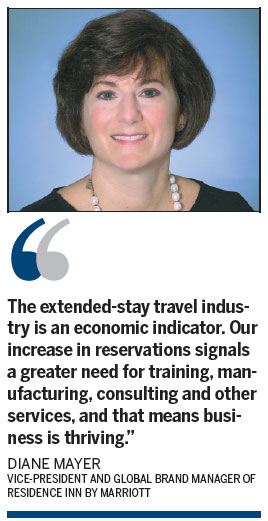Seeing double
Updated: 2014-07-12 06:54
By Pauline D.Loh (China Daily)
|
||||||||
Residence Inn "operates with more knowledge of the extended-stay traveler ... and delivering on our guests' needs for more living space, beautiful and functional physical environments, and an energetic and passionate service staff is how we maintain our leadership position in the market."
This segment of the market is growing. At the moment, long-stay hospitality brands account for 1 percent of the Marriott group's business, but it goes up to 8 percent in the pipeline.
"The extended-stay travel industry is an economic indicator. Our increase in reservations signals a greater need for training, manufacturing, consulting and other services, and that means business is thriving," Mayer had said in a previous statement.
It still holds true, especially in China, where all major international hospitality groups are gazing longingly for its market potential. It is harder and harder to profit as competition gets heated and crowded and, already, room rates in the top hotels are being forced down.
As the country gets down to real business and the novelty of reckless spending slowly calms, it is brands like Residence Inn and Courtyard that will fill the vacuum.
Let's look at how double-branding works, according to the Marriott model.
The Residence Inn is an all-suite hotel, with a kitchenette attached to the bedroom, a little living and study area designed to cater to the long-stay business traveler averaging about two weeks or more. Amenities are basic, no-fuss and the location is usually central.
Its twin brand, the Courtyard, caters to travelers who want an extended stay, but for a relatively shorter period. Both brands often share the same lobby, the gym and the swimming pool, and a restaurant where breakfast is served daily.
In Los Angeles, the Marriott group also does a high-end brand pairing. Just across the road from the Residence Inn/Courtyard is the Ritz-Carlton and JW, where celebrity chef Wolfgang Puck parks his WP 24 restaurant.
Both brands retain their signature decor styles, but the shared facilities make great economic sense in times when sustainable use of resources is a tipping point for socially conscious guests.
On the swimming pool level of the Ritz-Carlton, for instance, you can enjoy a view of LA by day and night, a good swim in an attractive pool and wander through an herb garden where the Ritz-Carlton and JW chefs harvest lemons, limes, rosemary, basil, oregano and pomegranates among other seasonal plantings. The artichokes are a decorative feature.
Mayer says they are already looking at Chengdu, where the group already has a Ritz-Carlton. Business travelers may soon be booking into a Residence Inn/Courtyard.

 Faye Wong's manager refutes star's drug rumors
Faye Wong's manager refutes star's drug rumors
 Lu Yi and daughter Bei Er pose for street snaps
Lu Yi and daughter Bei Er pose for street snaps
 Photoshoots of actress Li Xiaomeng
Photoshoots of actress Li Xiaomeng
 Council of Fashion Designers of America Awards
Council of Fashion Designers of America Awards
 Fan Bingbing, first Chinese actress in Barbie Hall of Fame
Fan Bingbing, first Chinese actress in Barbie Hall of Fame
 Awarding ceremony of 2014 hito Pop Music held in Taipei
Awarding ceremony of 2014 hito Pop Music held in Taipei
 Zhao Liying's photo shoot for Children's Day
Zhao Liying's photo shoot for Children's Day
 'Taken 2' grabs movie box office crown
'Taken 2' grabs movie box office crown
Most Viewed
Editor's Picks

|

|

|

|

|

|
Today's Top News
Bus carrying Chinese tourists crashes in US
LeBron James back to Cleveland
China, US pledge partnership
RMB use is on the rise in US
Chinese see NYC real estate as a sound place
Australia is top destination for wealthy Chinese
Berlin expels US spy official
China-US investment treaty on fast track
US Weekly

|

|








